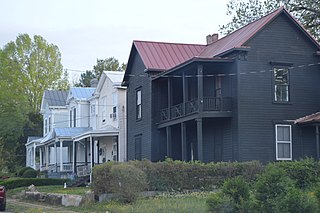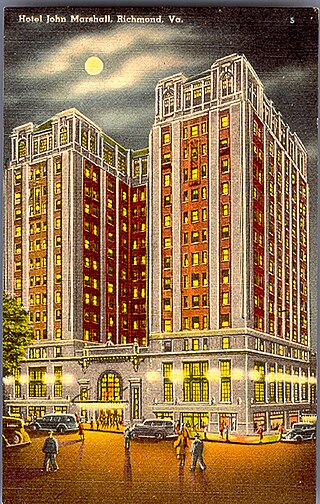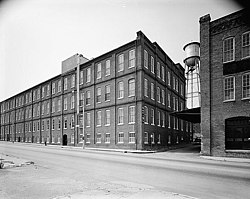
Farmville Historic District is a national historic district located at Farmville, Prince Edward County, Virginia. It encompasses 246 contributing buildings and 1 contributing object in the central business district and surrounding residential areas of Farmville. It includes a variety of commercial, residential, institutional, and industrial buildings dating from the mid-19th to early-20th centuries. Notable buildings include the Paulett-Gill house, Farmville Presbyterian Church, Johns Memorial Episcopal Church (1881), Farmville Methodist Church (1907), Hotel Weyanoke (1925), the warehouses of the Dunnington Tobacco Company and Central Virginia Processing, Inc., the former Craddock-Terry Shoe Company, the former Cunningham and Company tobacco prizery, Norfolk and Western Railroad passenger station, Doyne Building, the Watkins M. Abbitt Federal Building (1917), Prince Edward County Courthouse, and the former Farmville High School (1913). Located in the district is the separately listed First Baptist Church.

The Clarksville Historic District is a national historic district located at Clarksville, Mecklenburg County, Virginia. It encompasses 171 contributing buildings, 2 contributing sites, and 1 contributing structure in the central business district and surrounding residential areas of the town of Clarksille. Notable buildings include the Planters Bank (1909), Planters Brick Tobacco Sales Warehouse, Gilliland Hotel, the Russell's Furniture, former Clarksville High School (1934), Clarksville Presbyterian Church, Mount Zion Baptist Church, Jamieson Memorial Methodist Episcopal Church (1901), St. Timothy's Episcopal Church (1917), and St. Catherine of Siena Roman Catholic Church (1947). Located in the district are the separately listed Clark Royster House and the Judge Henry Wood Jr. House.

The Danville Historic District, also known as the Millionaire's Row and Old West End Historic District, is a national historic district located at Danville, Virginia. In 1973, the 110-acre (45 ha) district included 272 contributing buildings. They are considered the finest and most concentrated collection of Victorian and Edwardian residential architecture in Virginia. It includes notable examples of the Gothic Revival and Romanesque Revival styles. Located in the district is the separately listed Langhorne House, Penn-Wyatt House, and the Sutherlin Mansion, the last official residence of President Jefferson Davis.

Salem Veteran Affairs Medical Center(VAMC) is a Veterans Affairs hospital located in Salem, Virginia. Health care services are provided to veterans living in a 26-county area of Southwest Virginia. In addition to the main facility in Salem, there are affiliated services in three community-based outpatient clinics. These clinics are located in Danville, Lynchburg, Tazewell, Wytheville, and Staunton.

Buchanan Historic District is a national historic district located at Buchanan, Botetourt County, Virginia. It encompasses 277 contributing buildings, 5 contributing sites, and 4 contributing structures in Buchanan and Pattonsburg on both sides of the James River. They include commercial, transportation-related, domestic, religious, and industrial resources associated with the community's development from the late-18th century through the late-20th century. Notable buildings include the Pattonsburg Mill (1838), Buchanan Presbyterian Church (1845), Trinity Episcopal Church (1842), Hotel Botetourt (1851), Sorrell House (1850), James Evans Mason Lodge (1884), Virginia Can Company complex (1903), "Oak Hill" (1840), Town Hall Municipal Building, Bank of Buchanan, Ransone's Drugstore, Buchanan Theatre (1919), and Buchanan High School (1928). The contributing sites include the James River & Kanawha Canal project site, Johnston-Boyd Cemetery (1835–1906), and Mountain View Cemetery (1854). The contributing structures include the Stone Arch Tunnel (1870s). Also located in the district is the separately listed Wilson Warehouse.

Delaplane Historic District is a national historic district located at Delaplane, Fauquier County, Virginia.

Gloucester Downtown Historic District is a national historic district located at Gloucester Courthouse, Gloucester County, Virginia. The district encompasses 57 contributing buildings and 5 contributing sites. It includes the central business district and limited residential development directly connected to the historic court circle and Main Street extending east to Edge Hill, to include the Gloucester Women's Club.

South Boston Historic District is a national historic district located at South Boston, Halifax County, Virginia. The district includes 594 contributing buildings and 7 contributing structures in the Village of South Boston. It consists of industrial, commercial, and residential building types dating from the mid-19th century to the present. Notable buildings include the C.H. Friend School, New Brick Warehouse, Planters and Merchants Bank, Halifax Cotton Mill, R.J. Reynolds Tobacco Company tobacco prizery, former Liggett-Meyer Tobacco Company tobacco prizery, the Parkinson Block (1899), First Presbyterian Church (1887), First Baptist Church, and Mt. Olive Baptist Church.

Fieldale Historic District is a national historic district located at Fieldale, Henry County, Virginia. The district encompasses 329 contributing buildings and 2 contributing structures in the town of Fieldale. The majority of the buildings were built after 1916-1917 by the Marshall Field and Company as workers housing for the Fieldcrest Mills. Other notable buildings and structures include the Fieldcrest Mills Complex with the upper mill, lower mill, gatehouse, warehouse, water infiltration plant, and welder's shop; Danville & Western Station; Route 701 Bridge; Bank of Fieldale/Post Office; Fieldale Café (Fieldale Grocery; former Theater/Drug Store; Ramona's Dress Shop/Wilson's Grocery Store; Fieldale Elementary School ; Fieldale High School ; Fieldale Community Center ; Fieldale Hotel, and Fieldale Baptist Church. The former gas station building that houses Peggy's Antiques was built by the Lustron Manufacturing Company. Also located in the district and separately listed are the Marshall Field and Company Clubhouse and Virginia Home.

Smithfield Historic District is a national historic district located at Smithfield, Isle of Wight County, Virginia. It encompasses 289 contributing buildings and 2 contributing structures in the historic downtown and surrounding residential areas of Smithfield. There are 211 houses, 37 commercial buildings, 1 warehouse, 4 churches, 10 barns, 1 smokehouse, 23 garages, 1 farm office, 1 colonial kitchen, and 2 corncrib structures. Notable buildings include the original county clerk's office (1799), county jail, Wentworth-Barrett House, Wentworth–Grinnan House, King-Atkinson House, Smith-Morrison House (1770s), Hayden Hall, Boykin House, Goodrich House (1886), Thomas House (1889), Smithfield Academy (1827), Christ Episcopal Church, and Hill Street Baptist Church (1923). Located in the district and separately listed are the Old Isle of Wight Courthouse, Smithfield Inn, Windsor Castle Farm, and P. D. Gwaltney Jr. House.

North Danville Historic District is a national historic district located in Danville, Virginia. The district includes 426 contributing buildings in a primarily residential area of Danville. The district includes three blocks of primarily two-story, brick commercial buildings. Buildings within the district were constructed from around 1880 until roughly 1955 and reflect a wide variety of architectural styles, including vernacular Victorian, Italianate, Queen Anne, Colonial Revival, Tudor Revival, and bungalow designs. Many of these buildings were built by Dan River Cotton Mills founder T.B. Fitzgerald. Notable buildings include the Calvary United Methodist Church (1886), Shelton Memorial Presbyterian Church (1889), Bellevue Public School (1898), Washington Street Methodist Episcopal Church (1910), Keen Street Baptist Church (1927), and Woodrow Wilson High School (1926).

Marion Historic District is a national historic district located at Marion, Smyth County, Virginia. The district includes 361 contributing buildings, 2 contributing sites, and 1 contributing object in the central business district and surrounding residential areas of Marion. It includes a variety of residential, commercial, institutional, industrial, and governmental buildings primarily dating from the mid-19th to mid-20th centuries. Notable buildings include the Sheffey Loom House, Odd Fellows Lodge, Look & Lincoln Wagon Factory warehouse, the Beaux-Arts style Marion County Courthouse (1905), Mt. Pleasant Methodist Church, Courtview Building (1890s), Marion High School (1907-1908), Marion Junior College (1912), the Overall Factory, Weiler Building, Bank of Marion (1922), Royal Oak Presbyterian Church (1923), Marion Municipal Building (1935), Marion Post Office (1936), and a Lustron house (1948). Also located in the district are the separately listed Hotel Lincoln, Lincoln Theatre, Marion Male Academy, and Norfolk & Western Railway Depot.

Spotsylvania Court House Historic District is a national historic district located at Spotsylvania, Spotsylvania County, Virginia. The district includes 24 contributing buildings in the historic core of Spotsylvania. The principal building is the Spotsylvania Court House, a two-story Roman Revival style brick building built in 1839-1840 and extensively remodeled in 1901. The front facade features a tetrastyle portico in the Tuscan order. Associated with the courthouse is a late 18th-century jail and office and storage buildings erected in the 1930s. Other notable buildings include the Spottswood Inn, Berea Church (1856), Christ Church (1841), Dabney Farm, J.P.H. Crismond House, Harris House, and Cary Crismond House.

Danville Municipal Building is a historic city hall building located at Danville, Virginia, USA. It was built in 1926 and is a three-story, brick and concrete building faced in limestone in the Classical Revival style. Its front facade has a colonnade with Ionic order columns.

The Downtown Danville Historic District is a national historic district located at Danville, Virginia. The district includes 48 contributing buildings in the central business district of Danville. It includes a wide range of commercial, industrial, and institutional building types dating from the 1870s to the present. The district includes notable examples of the Late Gothic Revival, Tudor Revival, and Romanesque Revival styles. Notable buildings include the Danville City Auditorium (1932), Morotock Manufacturing Company (1907), J. T. Stovall Tobacco Factory (1876), Kingoff Building (1892), American National Bank & Trust Co, Woolworth's Building (1937), Southern Amusement Building (1922), Elks Home (1912), Danville Post Office (1932), Masonic Building (1921-1922), and Danville City Market (1930s). Located in the district are the separately listed Hotel Danville and the Danville Municipal Building.

Holbrook–Ross Street Historic District is a national historic district located in Danville, Virginia. The district includes 107 contributing buildings in a primarily African-American neighborhood of Danville. It includes a full range of late 19th and early 20th century residential, commercial, and institutional structures. The majority of the houses are single-family dwellings that were built between 1880 and 1910, and includes notable examples of vernacular Italianate and Queen Anne styles. Notable buildings include the Williams House, Hargraves-Geary House, Tisden House, Leroy Johnson House, Broadnax Apartment, Calvary Baptist Church (1896), Holbrook Street Presbyterian Church, Loyal Baptist Church (1924), Wesley AME Church (1939), Westmoreland Middle School (1936), and the Annex Building (1925). Located in the district are the separately listed Hotel Danville and the Danville Municipal Building.

The Grace Street Commercial Historic District is a national historic district located in Richmond, Virginia. The district encompasses 93 contributing buildings located in downtown Richmond. The buildings reflect the core of the city's early 20th-century retail development and the remnants of a 19th-century residential neighborhood. The buildings are in a variety of popular 19th-century and early 20th-century architectural styles, including Classical Revival, Mission Revival, International Style, and Colonial Revival. Notable buildings include the Administration and Equipment Building for the Chesapeake & Potomac Telephone Company (1929), Thalhimer's Department Store, Atlantic Life Building (1950-1959), Miller & Rhoads Department Store, Berry-Burk Building, former W. W. Foster Studios (1927), Bank of Virginia (1949), Investment Realty Company building (1930), W.T. Grant Store (1939), Hotel John Marshall (1927), Franklin Federal Savings and Loan building (1954), and the Tompkins House (1820). Located in the district and separately listed are the Loew's Theatre, Centenary United Methodist Church, Joseph P. Winston House, Central National Bank, and National Theater.

The Carver Industrial Historic District is a national historic district located at Carver, Richmond, Virginia. The district encompasses 13 contributing buildings located west of downtown Richmond. The industrial area developed between 1890 and 1930, along the tracks of the Richmond, Fredericksburg and Potomac Railroad. The buildings are in a variety of popular 19th-century and early 20th century architectural styles including Queen Anne and Romanesque.

Salem Avenue–Roanoke Automotive Commercial Historic District is a national historic district located of Roanoke, Virginia. It encompasses 59 contributing buildings in the southwestern part of the City of Roanoke. The district includes a variety of buildings having automotive, warehouse, light industrial and residential uses. Most of the buildings are small-scale, one or two-story brick or concrete block buildings, with the majority built between about 1920 and 1954. Notable buildings include the former Enfield Buick Dealership, Lindsay-Robinson & Co. Building (1918), Fulton Motor Company Auto Sales & Service (1928), Lacy Edgerton Motor Company, Roanoke Motor Car Company, and Fire Department No. 3 (1909).

The Waverly Downtown Historic District is a national historic district located at Waverly, Sussex County, Virginia. The district encompasses 48 contributing buildings, 1 contributing site, and 2 contributing structures in the central business district of Waverly. The buildings represent a variety of popular architectural styles including Folk Victorian and Italianate. They include residential, commercial, governmental, and institutional buildings dating from the mid-19th to mid-20th centuries. Notable buildings include the Waverly Municipal Hall, Atlantic and Danville Railroad Station, Masonic Lodge/Town Hall, Boarding House, Moss Hardware Building, Fleetwood Building (1904), Warner Grammer Store, Wilcox Building, former Waverly Post Office/ Palace Cigar and Pool Room (1961), and Waverly Town Shops and Water Tower (1932).
























